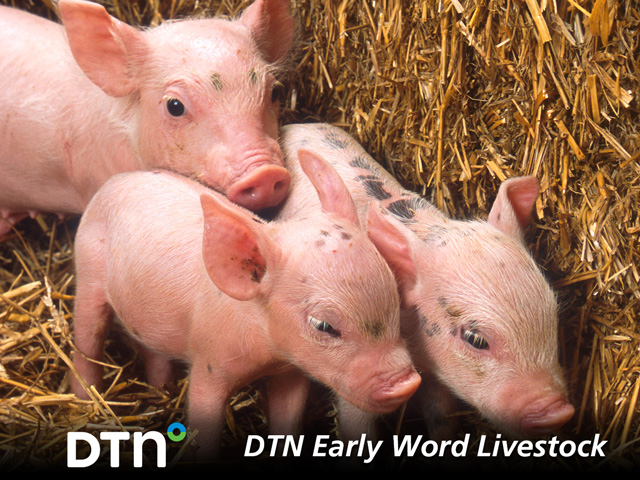DTN Early Word Livestock Comments
Monday's Losses Create More Widespread Market Uncertainty
Cattle: Steady Futures: Lower Live Equiv $298.03 +3.91*
Hogs: Lower Futures: Mixed Lean Equiv $126.75 +5.16**
* based on formula estimating live cattle equivalent of gross packer revenue
** based on formula estimating lean hog equivalent of gross packer revenue
General Comments:
Despite light cash cattle trade on Monday, there is limited direction in the cash markets given that trade volumes are not enough to establish a good working market trend. Showlists are generally higher, which is no surprise given the amount of backed up cattle through the countryside. Although packer activity is slowly increasing, it is very important to remember that current slaughter numbers are running 30,000 to 34,000 lower per day than year-ago levels, or typical levels seen before COVID-19 had an impact on overall packing plants. This reality of the inability to quickly increase packing plant runs over the upcoming days and weeks could limit widespread support through the complex based on the sheer number of cattle needing to move through the process. Limit losses Monday quickly took the wind out of the sails of the cattle complex as traders adjust from the recent market highs. At this point, prices are well over support levels, limiting any technical implications associated with limit losses. Expanded trading limits will be allowed in live cattle contracts, which may lead additional volatility to the complex Tuesday. Although the underlying support for increased demand for beef should help to limit overall losses through the upcoming days, the inability to aggressively increase packing plant activity may continue to keep the breaks actively applied to live cattle and feeder cattle futures. Tuesday slaughter is expected at 87,000 head.
Firm triple-digit losses Monday in June through August futures was not the signs the hog complex was looking for coming into the week. With all of the renewed focus on the ability for packing plants to restart production levels, the reality that even though plants are open and operating, the ability to move hogs through the system is at a much slower pace. This may be the new normal over the near term, and could limit overall hog movements and the availability of pork to end users. At this point, it is still hard to determine where the priority will be placed as to which retail ready products will see active production. Domestic pork demand typically accounts for increased processed meat products such as sausages, deli cuts and cured products, than beef or poultry. Given the limited slaughter numbers still seen, this could limit overall output of certain products more than others. Lean hog futures remain well above the support level, but the recent pullback from short-term highs over the last two trading sessions is starting to establish a wide, but potentially well entrenched sideways trend that could limit further support in the near future. Cash hog bids are expected 50 cents lower to 50 cents per cwt higher with most bids steady to 50 cents lower. Slaughter Tuesday is expected at 337,000 head. Saturday runs are expected near 189,000 head.
| BULL SIDE | BEAR SIDE | ||
| 1) | Continued strong gains in boxed beef values is still pointing to aggressive price surges in wholesale beef values. This may limit early pressure as the wide spread between wholesale meat prices and cattle prices continues to widen early in the week. | 1) | Limit losses in live cattle trade and significant pressure through feeder cattle futures was a punch to the gut for the complex as traders focus on the still delayed processing schedules and how this impacts market-ready cattle waiting for a shipping date. |
| 2) | Strong cash cattle movement and gains last week is expected to spark additional interest at steady-to-higher price levels. This should help to bring additional support to the overall complex and help to stabilize cash markets through the rest of May. | 2) | The continued deviation between cattle prices and wholesale boxed beef values is adding even more concern each day the price spreads widen. At some point these price relationships will return to a more normal spread, potentially creating even more volatility in the market than currently seen. |
| 3) | Increased overall demand for domestic pork through the upcoming days and weeks is expected to further fuel support in wholesale price levels. This should help to keep packers actively focused on increasing line speeds as the amount of workers coming to work allows. | 3) | Firm losses in cash hog values early in the week abruptly put the focus back on the inability to keep up with hog production levels due to the reduced packer capacity. Although plants are back open, the ability to move back to previous production levels still remains elusive. |
| 4) | Despite the recent market pullback, the technical support in lean hog futures continues with prices still well above recent support levels. This could help to rekindle additional support given the focus on potential renewed buyer activity as the week continues. | 4) | Firm early week pressure in lean hog futures trade is causing some additional concern that recent buyer support may quickly disappear as increased uncertainty surrounding trade agreements with China and the talk of further tariffs could greatly impact pork exports. |
Rick Kment can be reached at rick.kment@dtn.com
(c) Copyright 2020 DTN, LLC. All rights reserved.
P[L1] D[0x0] M[300x250] OOP[F] ADUNIT[] T[]




